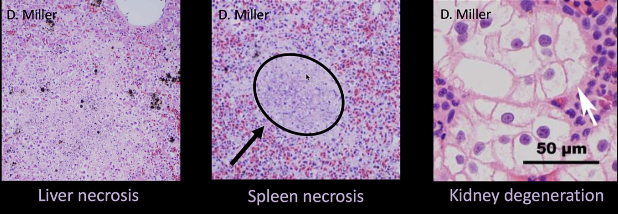
FNR24150 -- Week 15 Notes
What is a disease?
“Any deviation from, or impairement of the normal structure or function of any part, organ, or system of the living animal or plant body”
Clinical signs may be morphological, physiological, or behavioural
Morbidity, mortality, reduced growth, malnutrition, developmental, mental, activity level, appearance, etc.
Major types of diseases
Infectious
Contagious v. non-contagious
Genetic
Nutritional & physiological
Scurvy
Toxicological
Biotic v. non-biotic
Biotic: toxic algal blooms
Traumatic
Losing a limb
Mental Illness
Combinations
Agents of infectious disease
Microparasites
Bacteria, viruses, protists, fungi
Infected v. uninfected
Really the most important thing
Reproduce very quickly inside host
Macroparasites
Helminths (trematodes, nematodes, cestodes, acanthocephalans)
Arthropods (ticks, copepods, lice, insects, mites, fleas, etc.) & leaches
Intensity-dependent pathology
The more macroparasites you have, the greater the impact they have on you
Modes of transmission
Direct
Horizontal
Sneezing, coughing, etc.
Vertical
Parent to offspring
Single host
Multi-host
Indirect
Complex life cycle
Needs multiple hosts
Vector-borne
All parasites want to maximize transmission
Parasites and extinction
Parasites rarely drive their hosts to extinction
Transmission limited at low population sizes
Similar to predator-prey cycles
Several factors can help drive disease-induced extinction
Small populations (inbreeding, stochasticity)
Frequency-dependent transmission (STDs)
Multiple host species
If parasite is a generalist
Environmental reservoirs or persistence
Amphibian parasites
Host to a diversity of parasites
Viruses
bacteria
Fungi
Water mold
Trematodes
Most are relatively benign and the individual can clear the infection or live with it
3 Parasites of Conservation Concern
Batrachochytrium dendrobatidis (fungus)
Ranaviruses (virus)
Ribeiroia ondatrae (trematode)
Linked to mortality events, severe pathology (malformations), or extinctions
Relatively new to science (1996)
Appear to be increasing in prevalence in amphib populations either locally or globally
Chytrid fungus
Batrachochytrium dendrobatidis (Bd)
Non-hyphal parasitic fungus (aquatic)
Only chytrid species pathogenic to vertebrates
Attacks keratinized tissue
Larvae: only the mouthparts have keratin
Adults: Keratin found throughout skin
Life cycle
Zoospores
Floating around in water
Once contact is made, forms a cyst right under skin
Cyst continues to grow and eventually pops like a pimple
Goes on to infect more skin
Field signs of Bd infection
Lethargy and paralysis
Sloughing of skin and skin lesions
Time to death highly variable (18-48 days)
Infected individuals may appear healthy
Some species live with infection
May serve as reservoirs for other spp. to get infected from
Loss of pigmentation in mouth parts of larvae
Cause of Bd mortality
Impaired osmoregulation (suspected primary cause)
Decreased water uptake and ion exchange (sloughed skin)
Altered electrolyte/solute levels (decrease in calcium interferes with muscle activity)
Lethargy and paralysis
Impaired cutaneous respiration
Why is the fungus emerging?
2 hypotheses
Native pathogen
Increasing in prevalence due to some environmental change (climate change)
Increased amphib stress
Novel introduction
Pathogen somehow got introduced to a new area
Encountering hosts that have never evolved to deal with this pathogen
Africa → Central America, Australia, US
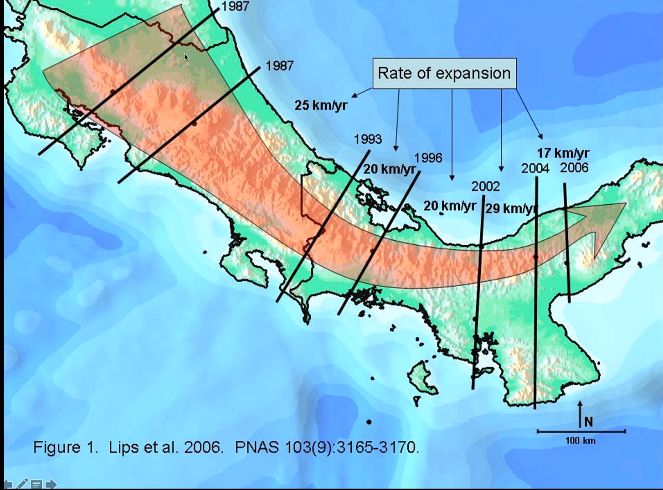
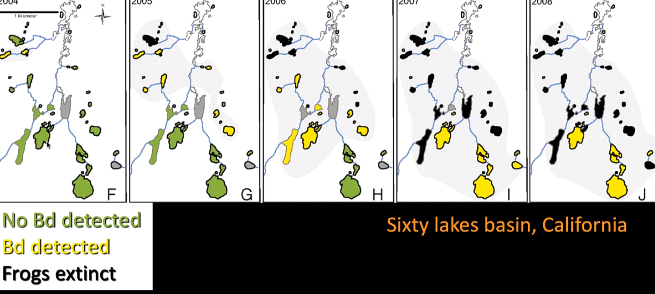
Bd Distribution
Present in most well sampled areas
While detected globally, the outcome of infection varies widely among regions

Bd: Patterns of susceptibility
Species vary widely in susceptibility to infection and disease outcomes
Extinctions have occurred
Frogs appear to be more susceptible than salamanders
Use of aquatic habitats increases chances of exposure
Some species act as reservoirs
Amphibian ranaviruses
Infect ectothermic vertebrates (herps and fish)
6 total spp.
3 spp. are known to infect herps (>15 isolates)
All 3 ranaviruses linked to amphibian die-offs
Ambystoma tigrinum virus (ATV)
Bohle iridovirus (BIV)
Frog virus 3 (FV3)
Characteristics
dsDNA (double-stranded DNA)
3x smaller than bacteria
Icosahedral shape (20 sides)
Paracrystalline arrays
Organ Destruction
3 primary organs: liver, spleen, and kidney
Cell death occurs within 6-9 hrs
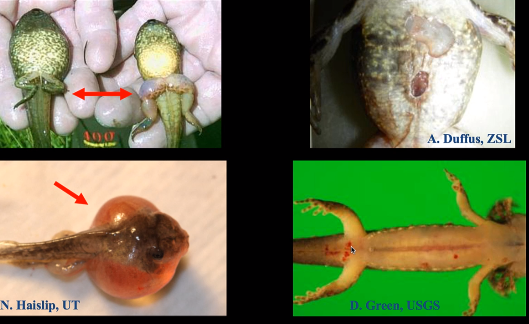
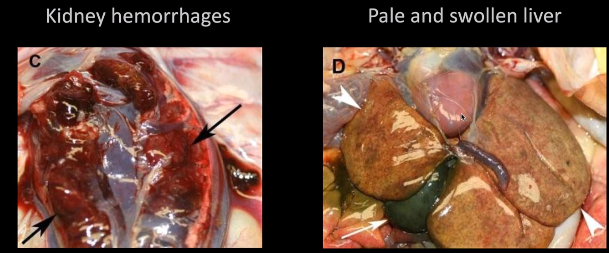
Fast progression
1-3 days signs, 3-7 days mortality
Persistence and transmission
Concerns typically evaporate along with bodies of water
Becomes a concern again when ponds form and adults congregate to breed
No vertical transmission; horizontal instead
Ranavirus: Patterns of susceptibility
Species vary widely in susceptibility to infection and disease outcomes
Population declines have occurred
FV3 → frogs; ATV → salamanders
Ranids highly susceptible to FV3
Wood frogs, tree frogs, etc.
Fast developing larvae = poorer immune functions
Some species may act as reservoirs
Parasite Infection → Deformed Frogs (Trematoda)
Ribeiroia ondatrae (Trematoda)
Parasitic fluke (Plathyelminthes)
Targets limb tissue
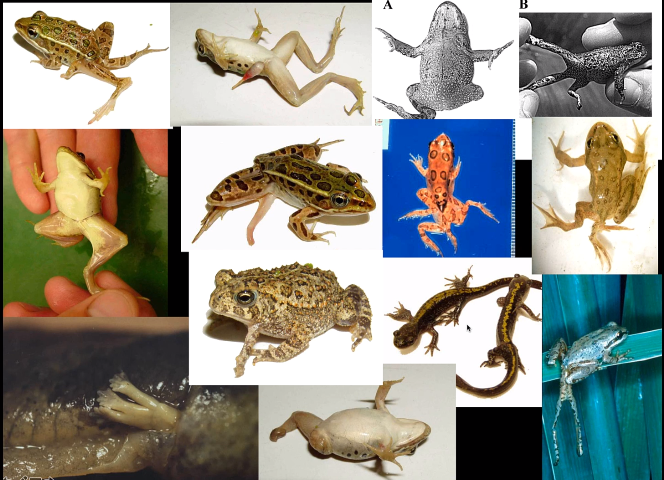
Cycle of deformity
aquatic snails
Picked up from infected bird feces
Rediae, cercariae
Asexual reproduction
Amphibs
Metacercariae
Waterfowl
Adults
Sexual reproduction
Extra legs serve to make predation easier (to complete parasite life cycle)
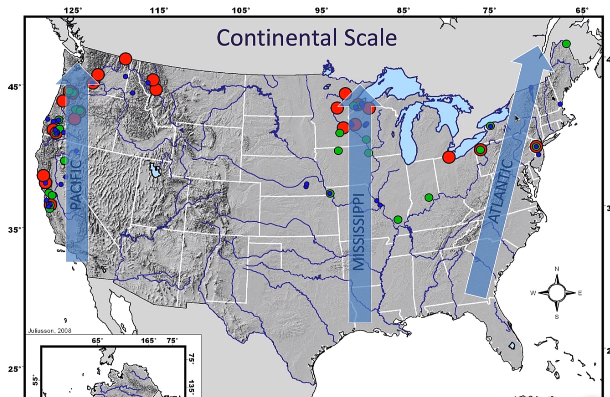
Human Influences
Factors that influence snail abundance should be linked to parasite load in amphibs and malformations
Eutrophication
Ecosystem response to the addition of artificial or natural substances, such as nitrates and phosphates
Bottom-up effect
Algal (plant) population growth increases due to the addition of fertilizer
Higher snail abundance → more infected snails → More cercariae per infected snail → more infection in amphibians
FNR24150 -- Week 15 Notes
What is a disease?
“Any deviation from, or impairement of the normal structure or function of any part, organ, or system of the living animal or plant body”
Clinical signs may be morphological, physiological, or behavioural
Morbidity, mortality, reduced growth, malnutrition, developmental, mental, activity level, appearance, etc.
Major types of diseases
Infectious
Contagious v. non-contagious
Genetic
Nutritional & physiological
Scurvy
Toxicological
Biotic v. non-biotic
Biotic: toxic algal blooms
Traumatic
Losing a limb
Mental Illness
Combinations
Agents of infectious disease
Microparasites
Bacteria, viruses, protists, fungi
Infected v. uninfected
Really the most important thing
Reproduce very quickly inside host
Macroparasites
Helminths (trematodes, nematodes, cestodes, acanthocephalans)
Arthropods (ticks, copepods, lice, insects, mites, fleas, etc.) & leaches
Intensity-dependent pathology
The more macroparasites you have, the greater the impact they have on you
Modes of transmission
Direct
Horizontal
Sneezing, coughing, etc.
Vertical
Parent to offspring
Single host
Multi-host
Indirect
Complex life cycle
Needs multiple hosts
Vector-borne
All parasites want to maximize transmission
Parasites and extinction
Parasites rarely drive their hosts to extinction
Transmission limited at low population sizes
Similar to predator-prey cycles
Several factors can help drive disease-induced extinction
Small populations (inbreeding, stochasticity)
Frequency-dependent transmission (STDs)
Multiple host species
If parasite is a generalist
Environmental reservoirs or persistence
Amphibian parasites
Host to a diversity of parasites
Viruses
bacteria
Fungi
Water mold
Trematodes
Most are relatively benign and the individual can clear the infection or live with it
3 Parasites of Conservation Concern
Batrachochytrium dendrobatidis (fungus)
Ranaviruses (virus)
Ribeiroia ondatrae (trematode)
Linked to mortality events, severe pathology (malformations), or extinctions
Relatively new to science (1996)
Appear to be increasing in prevalence in amphib populations either locally or globally
Chytrid fungus
Batrachochytrium dendrobatidis (Bd)
Non-hyphal parasitic fungus (aquatic)
Only chytrid species pathogenic to vertebrates
Attacks keratinized tissue
Larvae: only the mouthparts have keratin
Adults: Keratin found throughout skin
Life cycle
Zoospores
Floating around in water
Once contact is made, forms a cyst right under skin
Cyst continues to grow and eventually pops like a pimple
Goes on to infect more skin
Field signs of Bd infection
Lethargy and paralysis
Sloughing of skin and skin lesions
Time to death highly variable (18-48 days)
Infected individuals may appear healthy
Some species live with infection
May serve as reservoirs for other spp. to get infected from
Loss of pigmentation in mouth parts of larvae
Cause of Bd mortality
Impaired osmoregulation (suspected primary cause)
Decreased water uptake and ion exchange (sloughed skin)
Altered electrolyte/solute levels (decrease in calcium interferes with muscle activity)
Lethargy and paralysis
Impaired cutaneous respiration
Why is the fungus emerging?
2 hypotheses
Native pathogen
Increasing in prevalence due to some environmental change (climate change)
Increased amphib stress
Novel introduction
Pathogen somehow got introduced to a new area
Encountering hosts that have never evolved to deal with this pathogen
Africa → Central America, Australia, US


Bd Distribution
Present in most well sampled areas
While detected globally, the outcome of infection varies widely among regions

Bd: Patterns of susceptibility
Species vary widely in susceptibility to infection and disease outcomes
Extinctions have occurred
Frogs appear to be more susceptible than salamanders
Use of aquatic habitats increases chances of exposure
Some species act as reservoirs
Amphibian ranaviruses
Infect ectothermic vertebrates (herps and fish)
6 total spp.
3 spp. are known to infect herps (>15 isolates)
All 3 ranaviruses linked to amphibian die-offs
Ambystoma tigrinum virus (ATV)
Bohle iridovirus (BIV)
Frog virus 3 (FV3)
Characteristics
dsDNA (double-stranded DNA)
3x smaller than bacteria
Icosahedral shape (20 sides)
Paracrystalline arrays
Organ Destruction
3 primary organs: liver, spleen, and kidney
Cell death occurs within 6-9 hrs


Fast progression
1-3 days signs, 3-7 days mortality
Persistence and transmission
Concerns typically evaporate along with bodies of water
Becomes a concern again when ponds form and adults congregate to breed
No vertical transmission; horizontal instead
Ranavirus: Patterns of susceptibility
Species vary widely in susceptibility to infection and disease outcomes
Population declines have occurred
FV3 → frogs; ATV → salamanders
Ranids highly susceptible to FV3
Wood frogs, tree frogs, etc.
Fast developing larvae = poorer immune functions
Some species may act as reservoirs
Parasite Infection → Deformed Frogs (Trematoda)
Ribeiroia ondatrae (Trematoda)
Parasitic fluke (Plathyelminthes)
Targets limb tissue

Cycle of deformity
aquatic snails
Picked up from infected bird feces
Rediae, cercariae
Asexual reproduction
Amphibs
Metacercariae
Waterfowl
Adults
Sexual reproduction
Extra legs serve to make predation easier (to complete parasite life cycle)

Human Influences
Factors that influence snail abundance should be linked to parasite load in amphibs and malformations
Eutrophication
Ecosystem response to the addition of artificial or natural substances, such as nitrates and phosphates
Bottom-up effect
Algal (plant) population growth increases due to the addition of fertilizer
Higher snail abundance → more infected snails → More cercariae per infected snail → more infection in amphibians
